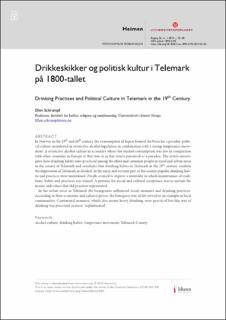Drikkeskikker og politisk kultur i Telemark på 1800-tallet.
Peer reviewed, Journal article
Published version
Permanent lenke
https://hdl.handle.net/11250/2647745Utgivelsesdato
2019Metadata
Vis full innførselSamlinger
Originalversjon
Heimen - Lokal og regional historie. 2019, 56 (1), 25-38. 10.18261/issn.1894-3195-2019-01-03Sammendrag
In Norway in the 19th and 20th century the consumption of liquor formed the basis for a peculiar political culture manifested in restrictive alcohol legislation in combination with a strong temperance movement. A restrictive alcohol culture in a country where the alcohol consumption was low in comparison with other countries in Europe at that time is in this article perceived as a paradox. The article investigates how drinking habits were practiced among the elites and common people in rural and urban areas in the county of Telemark and concludes that drinking habits in Telemark in the 19th century confirm the impression of Telemark as divided. In the rural and western part of the county popular drinking habits and practices were maintained. People seemed to express a mentality in which maintenance of traditions, habits and practices was valued. A premise for social and cultural acceptance was to sustain the norms and values that old practices represented. In the urban areas in Telemark the bourgeoisie influenced social manners and drinking practices. According to their economic and cultural power, the bourgeois way of life served as an example in local communities. Continental manners, which also meant heavy drinking, were practiced but this way of drinking was perceived as more “sophisticated”.

